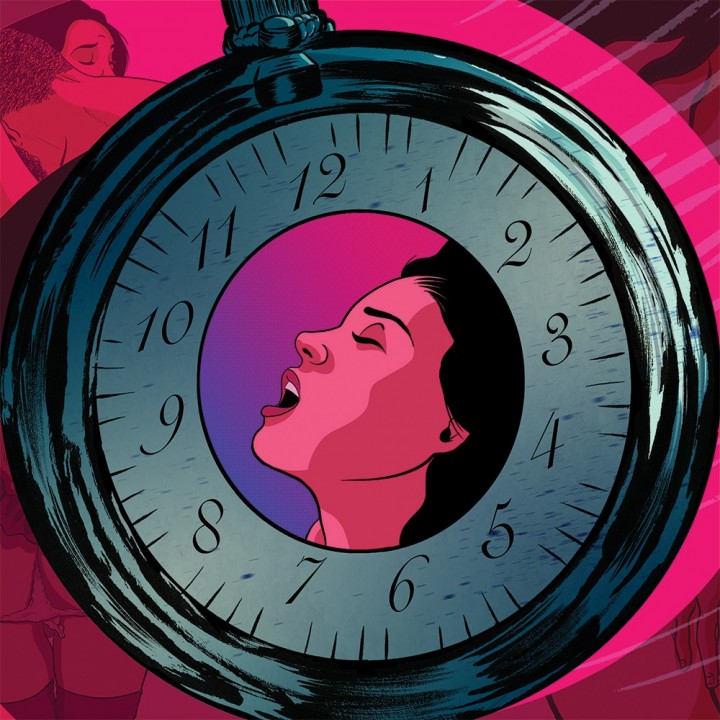
All Juice, No Seeds: My Vasectomy & Me
One man's life-changing journey to the chop shop
From the minute I saw how they were made, I knew I’d never want to have children. From the minute I saw how they were made, I knew I’d never want to stop doing what was required to make them.
In my late teens, I began to memorize the Woody Allen litany of clichés employed to keep women seeking a “serious commitment” at bay. I used the two most popular to great success right into my late thirties: “How could you possibly bring a child into this horrible world,” and the classic, “Having a child is so selfish.”
Decades later and a much different man, in less than 15 minutes I eliminated multiple potential problems for my wife Cristine and myself, allowing us more personal, cultural and sexual freedom.
In 15 minutes any cisgendered man, resolute in his beliefs and free of fear and ego, can help unburden his wife or girlfriend, if just in one simple way.
Before we met in person, Cristine told me she’d also known from a young age she didn’t want children. It was a sign of our compatibility, and part of why we’re now happily married. In hindsight, I realize that an unconscious (sexist) part of my brain wasn’t certain she could make that promise to herself, or to me. She was 29 and I was 40. Despite Cristine’s unwavering allergy to dishonesty, a prehistoric part of myself suspected that she, like all women (I imagined), might later change her mind. I assumed the cliché of her biological clock would tick in and our relationship would collapse—that while I’d remain steadfast in my desire to remain childless, my wife, powerless against nature, would inevitably surrender to instinct.
As has been the case so often in my life, I was wrong. My wrongness was, looking back, predicated on fundamentally sexist assumptions.
My wife and I really like having sex, and the procedure would mean that, infertility aside, we could have sex on the subway or in an Olive Garden bathroom more easily.
Eight days after a referral from my GP, I had a consultation at the premier snip house in town, literally named the Toronto Vasectomy Clinic. (Its ultra-specialized name put to bed any worries I had about the procedure. You don’t quibble over cuts of meat when you’re at “The Butcher.”) I went in to be decommissioned five days after my consultation; two weeks from doc to chop shop. The only thing I needed to bring was a jockstrap. I was to wear it the following week should there be mild aching.
The waiting room was full of women, often holding young children. Their faces projected a combination of relief and joy.
My doctor used what’s called the “no needle, no scalpel” technique. While a scalpel is often employed to cut the skin of the scrotum, revealing the vas deferens, i.e. the tubes to be reckoned with, I instead had a hole poked in that most unseemly of body parts with a hemostat, an instrument with a tiny tip that penetrates the skin, through which the vas deferens are pulled out, snipped, cauterized and reinserted with no need for stitches. A local anesthetic from a brightly designed bottle was sprayed on my scrotum. I remained fully awake, maintaining surprisingly good banter with the woman sparing the world my genetic legacy.
At home, I couldn’t even find the wound.
So began the dice rolling. We reverse engineered a fertility app, finding out which days we could not get pregnant, and took advantage of that window. Women tend to dislike condoms as much as men; what’s different is that men aren’t encouraged or pressured by partners to try one of many potentially dangerous options, because really there are no other options for men right now. If men had to experience a tenth of the suffering women do in dealing with contraceptives or childbirth, lord knows scientists would be working around the clock.
According to the Centre for Young Women’s Health, the failure rate for condoms is 18 out of 100 (although most authorities on the subject add that condoms are around 98 percent effective when used properly). The birth control pill rate is half that, at nine (or one for "perfect use"). The same source situates the birth control pill as the most popular female contraceptive in North America, with IUDs a close second. Anecdotal information suggests otherwise: Most of my wife’s friends eschew the Pill, one common reason being that, with an IUD, no daily awareness is required. It’s replaced every three to 12 years, sometimes with painful complications.

The Argument for Making Contraception a Man's Responsibility
For International Women's Day, men should pick up the mantle when it comes to birth control
Earlier this year I put a call out to my Instagram followers, seeking other men’s vasectomy stories. I quickly learned from their replies that, at least today, the IUD is in style—and that a significant number of men have had vasectomies precisely because their partners, sisters or friends had suffered one of the many under-reported and shocking traumas associated with intrauterine devices. When I first began researching this article, search results for IUDs were primarily about their efficacy, with a noticeable number of pages devoted to new revelations about extreme side effects. Googling IUDs today, the first two pages are devoted almost entirely to ads from law offices soliciting people to join class action lawsuits. The most stunning side effects reported were of device dislocation, meaning that the IUD has migrated outside of the uterus. (I’ve only had a condom migrate off of me, creating scared looks on two faces and a trip to the store for a morning after pill.) There have been reports of other side effects far more serious than those listed by manufacturers in the informational sheets that accompany their products.
Among the many contraception options for women, those with the lowest failure rates—the IUD, at roughly one in 100 times, and the Pill—have the worst side effects, ranging from vaginal dryness to “mood changes.” As you go down the list, the failure rates increase and the side effects diminish. For women, birth control becomes mostly side effect-free once you reach the cervical cap, which fails about 17 to 20 out of 100 times. The next least efficacious option is the male condom, which again, fails up to 18 times.
The failure rate of vasectomies? 0.15 percent. Not one out of 100; 0.15 out of 100. And this miniscule number is attributed to surgical, not user error.The two main risks involved with the vasectomy option are that the vas deferens may reattach (one in 1,000), leading to unwanted pregnancy, and what’s called “post-vasectomy pain syndrome.” One to two percent will suffer with this disorder. The overwhelmingly reliable side effects: Your partners stops worrying about babies and side effects, and you can be more sexually spontaneous.
After the procedure, my balls ached for a few weeks. Mildly. After 20 ejaculations to clear motile sperm from my system, I was good to go.
And then I went.
Possessing mild libido paranoia myself, I’d asked my consulting doctor if my testosterone count would change, or if sex would be any different. He said sex would be different only in that I’d likely have it more often. Time has proved this to be true.
The man with bros requiring reassurance said he simply told them the choice had no bearing on his virility, and that “the only thing which can’t be reversed is having a child.”
Some men seem to subconsciously equate an inability to knock up women with a decline in sexual prowess.
In describing how they wanted to “balance the scales,” they were demonstrating an awareness of the inequity that dominates the birth-control landscape, and in doing so they revealed themselves and their vasectomies to be feminist by default.
1. Men would require permission from their sexual partners before they were able to obtain Viagra or any other erectile dysfunction medication.
2. Vasectomy procedures would be banned, with the punitive measures for doctors the same as those in HB 481, which would imprison abortion providers.
3. Men who had sex without condoms would be charged with aggravated sexual assault.
4. DNA testing would be required once women were 6 weeks and 1 day pregnant. The determined father of the child would then have to immediately begin making child support payments, as Georgia law states that after 6 weeks and a day, an embryo becomes a human life.
5. 24 hour waiting periods would be implemented before men could purchase porn or sex toys in the state of Georgia.
Speaking with me over email last month, Rep. Kendrick explained the bill’s inspiration: “When HB 481 was proposed, I thought, ‘How can we change the narrative to get people to think about how women feel about their bodies being the topic of discussion?’ So I asked for a few suggestions on social media and one early morning (I am a super early riser), I said, ‘Let me just post this to get people talking and thinking.’ I never expected it to blow up like it did. Never.”
When HB 481 was proposed, I thought, ‘How can we change the narrative to get people to think about how women feel about their bodies being the topic of discussion?’
Kendrick knows firsthand the double standard of contraception in America: She once lost two weeks of her own birth control pills and when she asked her pharmacy for refills, they refused. Even if refilled, her insurance company wouldn’t have paid for it. As she said, “Now what sense does this make when men can go anywhere at any time and get condoms?”
To Kendrick’s surprise, the child-support section of her bill appeared, in slightly altered form, in the draft of HB 481 signed into law back in May. “Someone thought my crazy idea was actually a good idea,” she said; “go figure.” She predicted that the bill would work its way through the court system until, “Surprise surprise, it will be struck down in federal courts, as it violates Roe V. Wade.” But then challenging Roe v. Wade seemed to be one of HB 481’s main goals from the beginning.
Kendrick hadn’t expected her proposal to receive as much attention as it has, but the Testicular Bill of Rights has already done what she intended. I hope it will continue to show men what Draconian bullshit women deal with when it comes to reproductive rights.
I told Rep. Kendrick I’d had a vasectomy, to which she replied, “God bless you.” While nice to hear, ideally my decision wouldn’t be blessworthy. In the face of a system that increasingly polices women’s bodies, vasectomies are more than considerate procedures. What they represent is something urgently needed: active empathy for women and the nightmarish scenarios they’re forced to contend with.
Fear not, men: You can still bust nuts all over the place. You’ll also, however, be forestalling abortions that could send your partner or her doctor to prison.
Thirty minutes from the waiting room to the bedroom.
I can give you my doctor’s number.






